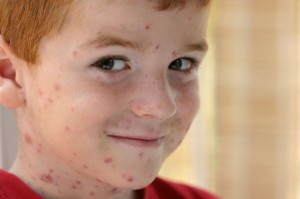
More evidence that low-calorie sweeteners are bad for your health
Studies show that artificial sweeteners can raise the risk of hypertension, metabolic syndrome, type 2 diabetes and heart disease, including stroke.

You’ve probably heard a lot of talk about childhood infectious diseases and a big one of these is chickenpox. But how much do you really know about it, and would you know the signs and symptoms if they were to strike you or your family?
Chickenpox is a contagious infection caused by the herpes varicella zoster virus (part of the herpes family). It is easily spread through coughs and sneezes of the affected person as it is an airborne virus. Also coming into contact with the secretions from the spots is also a major way to spread the virus. It is also possible to get it from handling items where the droplets have landed, such as toys and sheets.
Who can get chickenpox?
Anyone can get chickenpox, young or old. It is most common in children under 10 years of age.
It is possible to get chickenpox at any time of the year, but it’s most common in spring and winter.
Usually once someone gets chickenpox they will produce the antibodies so that they them become immune to further infection. However, on occasion this does not happen so a person could get chickenpox more than once in their lifetime. In addition, anyone who has had chickenpox is more prone to getting shingles as adults.
Signs and symptoms
A person can be exposed to the virus 7-21 days before the symptoms start to show – this is referred to as the ‘incubation period’.
The most infectious time is from 1-2 days before the spots show up until the spots crust over.
There are often a few warning signs just before the spots come out, these are very much like mild ‘flu symptoms and can include:
The spots themselves appear shortly after this. It starts as an itchy rash in small clusters in different parts of the body. Some get them over the chest/tummy, others it’s arms and legs, some get them behind their ears. The spots can spread all over the body, including in the mouth, ears, nose, genitals and soles of feet.
The rash starts out flat and then slowly becomes more raised, forms a blister and becomes itchier. This can take 12-14 hours. It can take another 2-3 days before the crust then forms on top of these spots. However, it can take 1-2 weeks before the crusts all drop off.
Spots can keep developing for days after the first spots appeared.
If the spots become very red and inflamed or if there are any pains in the chest or difficulty breathing then it is best to seek medical advice straight away.
Spreading chickenpox
The infected person should not go to school, nursery or work and should stay at home from the start of the symptoms until the last blister has burst and crusted over.
If you have been exposed to the virus then it is best to avoid anyone who is pregnant, newborn babies, anyone with weakened immune systems, patients on chemotherapy or anyone in hospital.
Airlines will also not allow anyone to fly until 2 weeks after the last spot has crusted over. Best thing is to check with your airline and travel insurance.
Another good way to prevent the spread of the virus is to disinfect all objects (including toys and sheets) which may have been exposed to the virus.
Fingernails should be kept short to avoid over scratching and infecting, plus spreading the virus.
Patients should be kept cool and loose, comfortable clothes should be worn to avoid scratching.
Is it dangerous?
There are risks of complications from chickenpox, and most of these are related to bacterial infections from the spots. This is most likely to occur in those people who scratch their spots a lot. There is also a small risk of viral pneumonia, encephalitis in some individuals. Those with weaker or suppressed immune systems will be most at risk from any complications, as will pregnant women and newborn babies.
In addition older children and adults tend to suffer far more severe cases of the infection and more at risk of complications.
Also, pregnant women, newborn babies and people with compromised immune systems should contact their GP if they are exposed to the disease. They can do a blood test to check if that person has anti-bodies to protect them from infection. If not they will need to be monitored much more closely.
Treating chickenpox
Conventional medicine includes giving paracetamol for the fever and headaches and using calamine lotion to soothe the spots and itching. For more severe cases and in the case of adults the doctor may prescribe anti-virals which are very strong.
I often get asked about natural remedies that could help as well, so I’ve listed a few below. However, it is worth remembering that this does not replace any medical advice and if there are any concerns you should always seek the advice of a doctor.
Baths
Room sprays
To help ‘clear’ the air and to also aid sleep you can diffuse the following essential oils:
You could also make a room spray using these essential oils by diluting 2-3 drop of the chosen oils in a tablespoon of vodka which is then added to a spray bottle full of water.
Body lotions
The idea is to help reduce the itching and irritation of the spots. This can be done using any of the following mixes:
Ears and mouth

Please subscribe me to your newsletter mailing list. I have read the
privacy statement